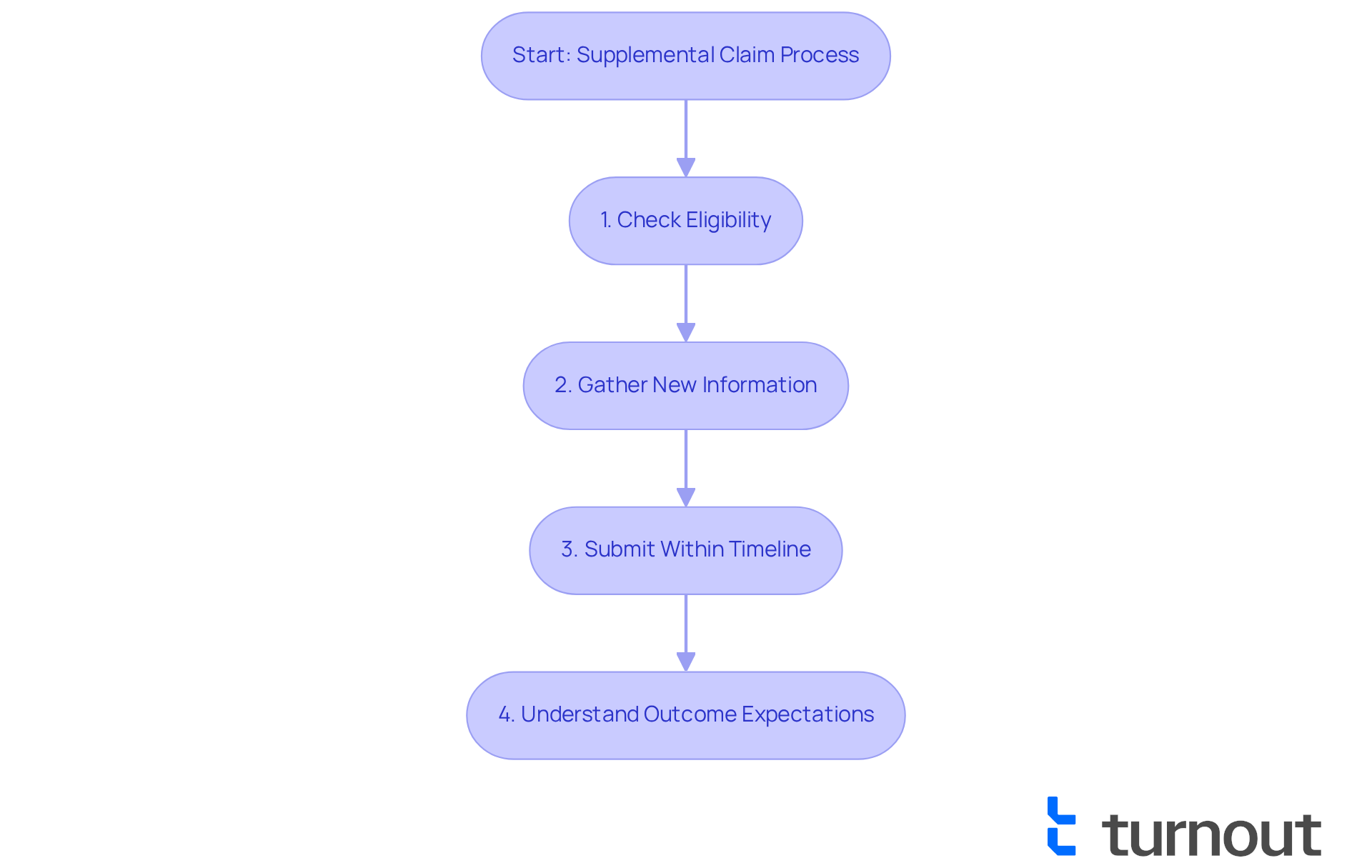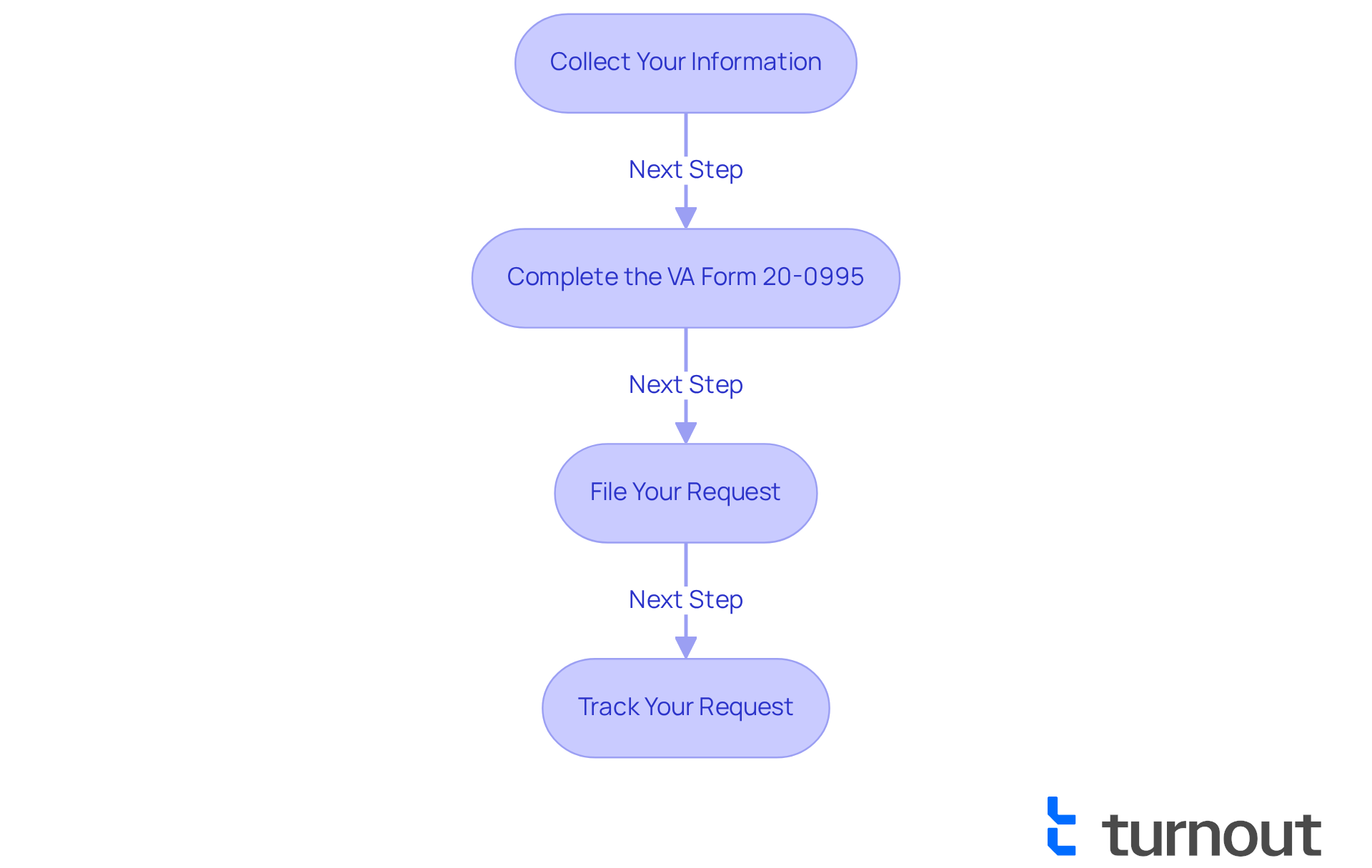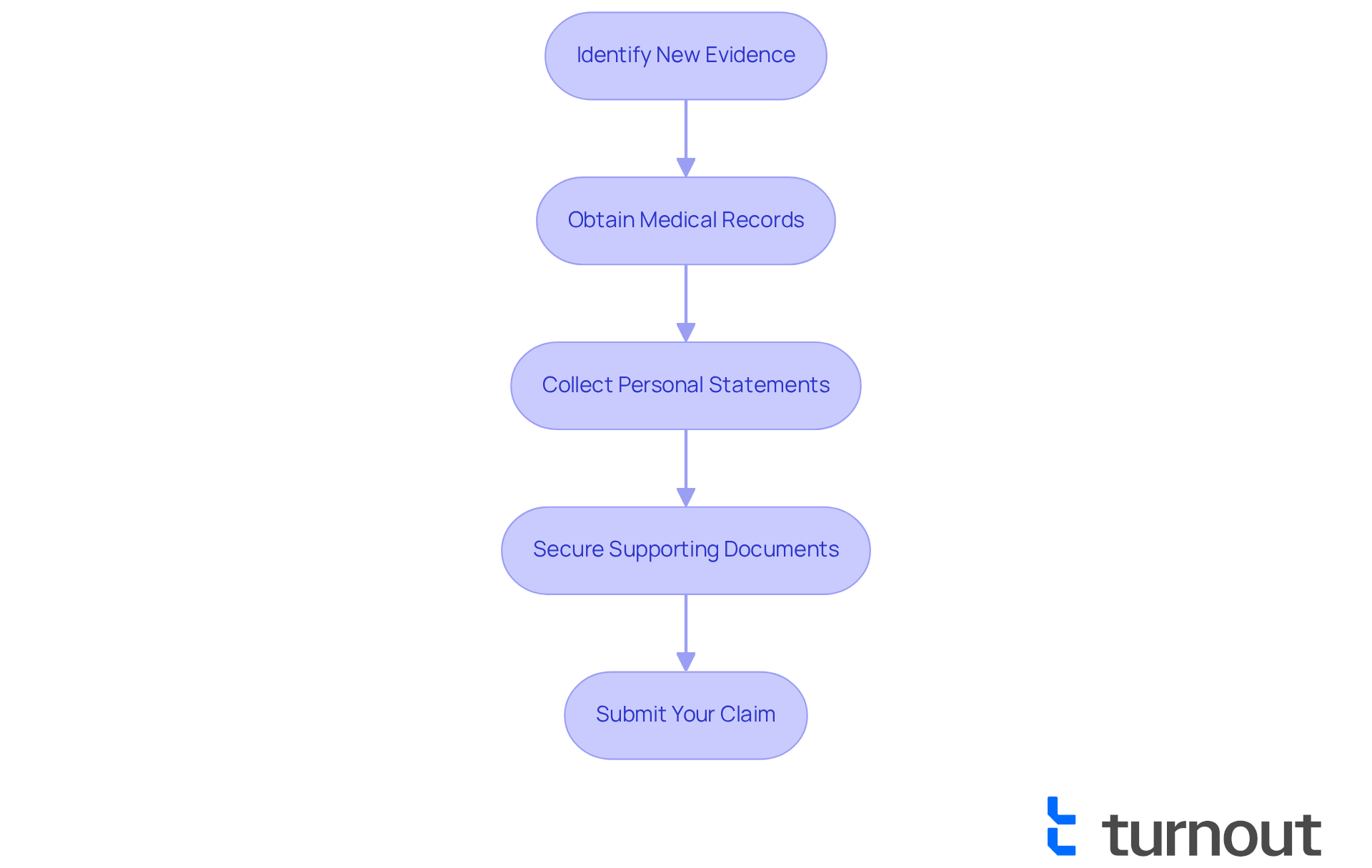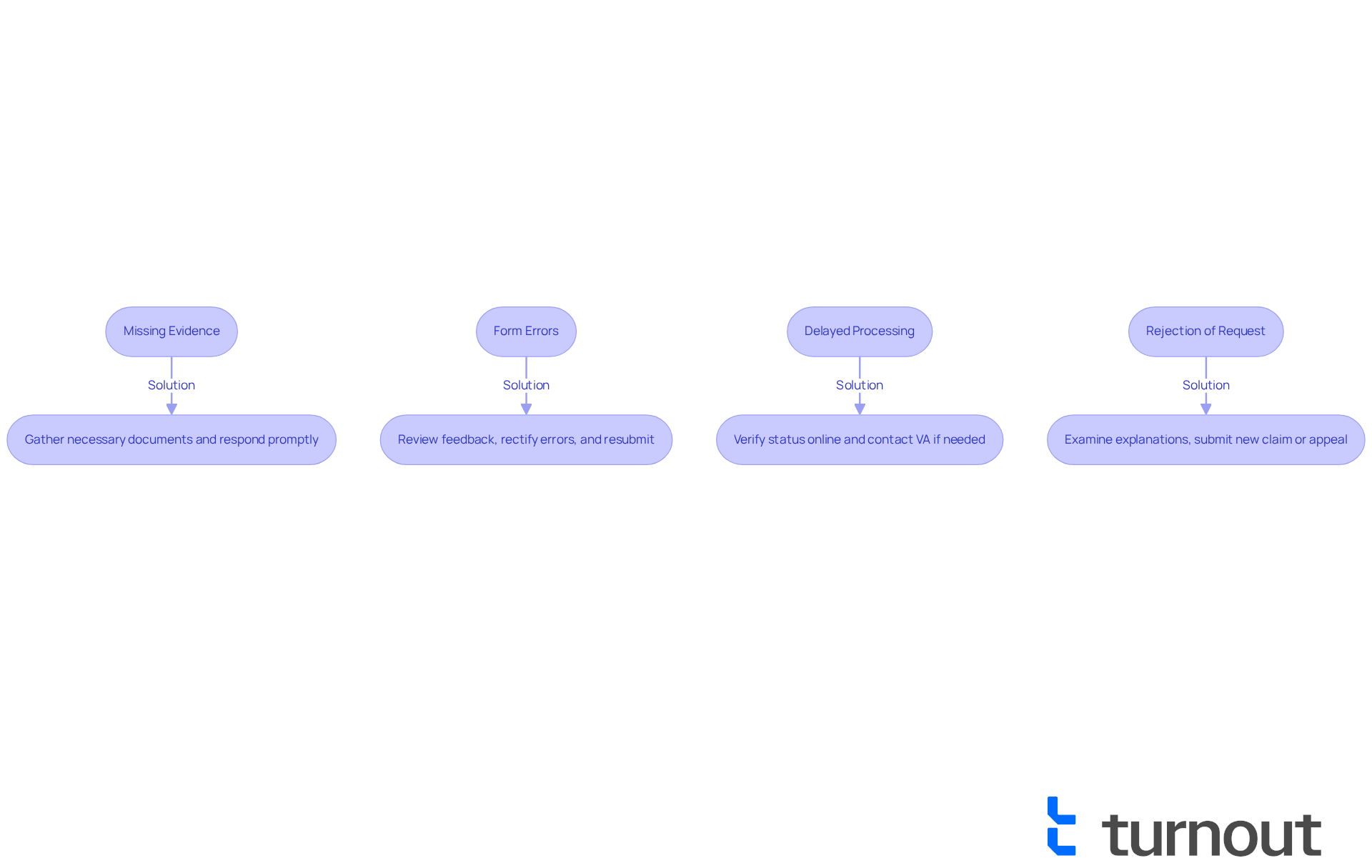Overview
Navigating the VA supplemental claim process can feel overwhelming, but you are not alone in this journey. This article outlines four essential steps to help you successfully move through the process:
- Understanding eligibility
- Gathering new evidence
- Filing requests
- Tracking outcomes
We understand that thorough preparation and accurate submission are crucial to enhancing your chances of a favorable decision.
First, let’s focus on eligibility. Knowing your rights and the criteria can empower you to take the next steps confidently. Next, gathering new evidence is key. This article provides detailed guidance on how to collect the necessary documentation, ensuring you present the strongest case possible.
Filing requests is another critical step. It’s common to encounter challenges during this phase, but we’re here to help you navigate through any common filing issues you might face. Finally, tracking outcomes is essential to stay informed about your claim's progress.
Remember, you don’t have to face this alone. With the right preparation and support, you can enhance your chances of achieving a positive outcome. Take a deep breath, and let’s move forward together.
Introduction
Navigating the complexities of the VA supplemental claim process can feel overwhelming for many veterans. We understand that ensuring your disability rating accurately reflects your true condition is a significant concern. This guide aims to illuminate the essential steps and strategies needed to successfully file a supplemental claim, empowering you to advocate for yourself effectively.
However, with a myriad of potential pitfalls and the emotional weight of past decisions, it’s common to wonder: how can you ensure your submission stands the best chance of success? You are not alone in this journey, and together, we can explore the path forward.
Understand the VA Supplemental Claim Process
Navigating the supplemental claim process with the VA can feel overwhelming, especially if you believe your disability rating is inaccurate or if you have new evidence to support your case. This process is designed to give you the opportunity to file a supplemental claim for a review of a previous VA decision. Let’s explore the key components together:
- Eligibility: It’s important to ensure you qualify to submit an additional request. Typically, this means you have previously filed a claim and received a decision from the VA.
- New Information: Your supplemental claim must include fresh and relevant information that wasn't part of your initial claim. This could be medical records, personal statements, or other documentation that supports your case.
- Filing Timeline: Be mindful of the timelines involved. You have one year from the date of the VA's decision to submit your supplemental claim.
- Outcome Expectations: Understand that the VA will review your new information and make a decision. This could lead to a higher rating, a rejection, or a request for more details.
By grasping these fundamentals, you can approach the filing process with confidence and clarity. Remember, you are not alone in this journey, and we’re here to help you every step of the way.

Follow the Step-by-Step Filing Procedure
Filing your supplemental claim with the VA can feel overwhelming, but we're here to guide you through each step with care and understanding.
-
Collect Your Information: Start by gathering all recent data that supports your claim. This may include medical records, lay statements, or any other documentation that hasn’t been submitted before. Strong evidence, such as witness statements and expert opinions linking your condition to military service, can significantly enhance your case. Remember, many veterans feel underrated by the VA, so thorough preparation is crucial.
-
Complete the VA Form 20-0995: This is the official document for submitting your additional request. It’s important to fill out all sections accurately and in detail. Common mistakes include leaving sections incomplete or forgetting to attach necessary supporting documents. You can find this form on the VA's website or through your local VA office. Experts highlight that precise completion of this form is essential for a successful request.
-
File Your Request: You have options for filing your request: online via the VA's website, by mail, or in person at your local VA office. Be sure to keep copies of all documents you submit, as this will help you monitor your request and respond to any inquiries for further information. Typically, it takes about 79.3 days to finalize a supplemental claim, though this may vary depending on the complexity of your situation.
-
Track Your Request: After you submit your request, you can track its status through the VA's online portal. This will keep you informed about any updates or requests for additional information. If you encounter challenges, know that many veterans have successfully navigated this process, with some achieving a 100% disability rating after years of perseverance.
By following these steps, you can ensure that your additional submission is filed accurately and efficiently, increasing your chances of a positive outcome. Remember, you are not alone in this journey, and we’re here to help you every step of the way.

Gather Necessary Evidence and Documentation
Collecting the appropriate evidence is crucial for a successful supplemental claim. We understand that this process can feel overwhelming, but here’s how to navigate it effectively:
- Identify New Evidence: Review your previous assertion and pinpoint any new information that could strengthen your case. This may include recent medical diagnoses, treatment records, or updates on your condition.
- Obtain Medical Records: Reach out to your healthcare providers to request copies of your medical records. Ensure these documents are up-to-date and directly pertinent to your situation, as they play a crucial role in establishing the severity of your condition. As noted by VA disability benefits expert Brian Reese, "Be accurate, consistent, and bring strong medical evidence of current severity."
- Collect Personal Statements: Write a personal statement that outlines how your condition impacts your daily life and ability to work. This narrative can offer valuable context and insight into your circumstances, enhancing the overall strength of your argument.
- Secure Supporting Documents: Collect any additional papers that may substantiate your assertion, such as employment records, witness statements, or other relevant paperwork. Remember, the average successful VA claim includes a substantial number of documents, emphasizing the need for thoroughness. In fact, the projected success rate for supplemental claims submitted to the VA is approximately 50%, highlighting the significance of thorough documentation gathering.
By carefully gathering and structuring your information, you can present a compelling case to the VA. Keep in mind, the success of your additional request primarily depends on the trustworthiness and significance of the new documentation provided. Furthermore, it's common to feel anxious about timelines; the typical duration for processing a supplemental claim is around 5-6 months. Staying knowledgeable and proactive during your process is essential, and remember, you are not alone in this journey.

Troubleshoot Common Filing Issues
Even with careful preparation, we understand that issues can arise during the filing process. It's common to feel overwhelmed, but knowing how to troubleshoot these problems can make a significant difference. Here are some common challenges you might face and how to address them:
-
Missing Evidence: If the VA requests additional evidence, respond promptly. Review the request carefully and gather the necessary documents as quickly as possible. Remember, if you are submitting case reports, you may need to obtain approval from the patient or their legally authorized representative for the use of information in the report.
-
Form Errors: It can be frustrating when your submission is returned due to mistakes on the form. Carefully review the feedback provided, rectify any errors, and resubmit your request promptly.
-
Delayed Processing: If your request is taking longer than anticipated, verify the status online. It’s natural to feel anxious during this waiting period, and if there are significant delays, consider reaching out to the VA for clarification.
-
Rejection of Request: If your request is rejected, take a moment to examine the explanations provided by the VA. You can submit a new supplemental claim with further evidence or explore other avenues for appeal. Be mindful of the distinction between de-identified and identifying information when submitting your claims, as this can impact privacy considerations.
By being aware of these common issues and knowing how to address them, you can navigate the supplemental claim process with the VA more effectively. Remember, we're here to help, and you are not alone in this journey.

Conclusion
Understanding the VA supplemental claim process is vital for veterans seeking to rectify previous decisions or present new evidence related to their disability ratings. We understand that this journey may feel overwhelming. However, this process empowers individuals to advocate for their rights and ensures they receive the benefits they deserve. By following the outlined steps, veterans can approach their claims with the confidence and knowledge necessary for a successful outcome.
This article highlighted four key steps:
- Ensuring eligibility
- Gathering new and relevant information
- Adhering to filing timelines
- Understanding the potential outcomes of the claim
Each of these components is crucial in navigating the supplemental claim process effectively. By collecting strong evidence, completing the necessary forms accurately, and tracking the status of the submission, veterans can significantly enhance their chances of achieving a favorable result.
Ultimately, the journey through the VA supplemental claim process may seem daunting, but it is essential to remember that support is available. Veterans are encouraged to take proactive steps, seek assistance when needed, and remain persistent in their pursuit of justice. You are not alone in this journey. By doing so, you not only advocate for yourself but also contribute to a broader movement that seeks to ensure all veterans receive the recognition and benefits they rightfully deserve.
Frequently Asked Questions
What is the VA supplemental claim process?
The VA supplemental claim process allows individuals to request a review of a previous VA decision if they believe their disability rating is inaccurate or if they have new evidence to support their case.
Who is eligible to submit a supplemental claim?
To be eligible, you must have previously filed a claim and received a decision from the VA.
What type of new information is required for a supplemental claim?
The supplemental claim must include fresh and relevant information that was not part of your initial claim, such as medical records, personal statements, or other supporting documentation.
What is the filing timeline for a supplemental claim?
You have one year from the date of the VA's decision to submit your supplemental claim.
What can I expect regarding the outcome of my supplemental claim?
The VA will review your new information and make a decision, which could result in a higher rating, a rejection, or a request for more details.




